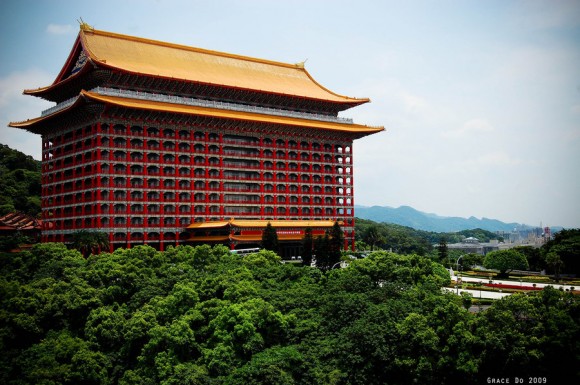Warning: Undefined array key "sharing_networks_networks_sorting" in /var/www/wp-content/plugins/monarch/monarch.php on line 3904
Warning: Trying to access array offset on value of type null in /var/www/wp-content/plugins/monarch/monarch.php on line 3904
With 487 rooms, flying rafters, and traditional folk art, Taiwan’s Grand Hotel looms its luxury over you far before reaching the entrance.
Guests first enter a giant majestic entrance hall, where they are greeted by a plush red carpet that covers most of the sleek tile floor. As they check in, the hall bustles with activity as other visitors take pictures or enjoy the small dessert café on the left. The outdoor stone lions stand tall, protecting the powerful message on the doors reading “Long Live the Republic of China.”
But the Grand Hotel isn’t only considered a landmark of the country for these impressive accommodations. The massive building of Chinese architecture is steeped in Taiwanese history and has been visited by world leaders such as Ronald Reagan and Nelson Mandela.
In fact, attracting iconic guests is a tribute to the hotel’s original purpose. In 1952, Madame Chiang Kai-shek, the wife of General Chiang Kai-shek, commissioned the building of the magnificent structure in an effort to catch the eye of powerful foreign guests. The commission came soon after the Kai-sheks led a retreat to Taiwan to evade communists in China. The hotel became more than just a place for visiting dignitaries to sleep– it was a stamp of defiance. In past years, the Grand Hotel was the site of many of Taiwan’s political strides, such as the development of political parties the Kuomintang and the Democratic Progressive Party.
However, not all of the hotel’s history has been as grand as its name. During a major renovation in 1995, a fire demolished the roof and it was discovered that senior managers embezzled about $1 million from the business. The staff was left to replace many of the upper floors and fix the building’s structural problems. But the hotel reflected much of the resiliency of Madame Chiang Kai-shek and Gen. Chiang Kai-shek. Despite the setbacks, the hotel recovered only three years later in 1998.
After the incident, Chairwoman Christine Tsung took the hotel in a different direction by appealing to a popular weak spot: food. An alliance was developed with Taiwan’s China Airlines, and soon business and first-class passengers could enjoy delectable food from the Grand Hotel’s kitchen. Some of these items included prawn balls and radish rice cakes literally fit for a king– the hotel gave passengers the same food that was served at President Chen Shui-bian’s May 2004 inauguration dinner.
But Chairwoman Christine Tsung’s changes didn’t stop there. In 2006, she also established a restaurant in the famous YM Oceanic Culture and Art Museum in Keelung. The opening of the restaurant helped to establish the Grand Hotel as a brand and showed everyone the luxurious amenities offered by their staff.
Although the hotel has come a long way since its strife with fire and communism, it’s still a popular place for visitors. Nowadays, the hotel’s beauty attracts tourists from various countries and its restaurant is a popular spot for local business meetings. For those looking to have a taste of history, try Madame Chiang’s favorite rice cake at the restaurant or see her dressing table in the presidential suite. Staying at Taiwan’s Grand Hotel is an experience unlike any other because visitors have the chance to eat and sleep in an iconic piece of the country’s history. You won’t have to leave the building to experience Taiwanese culture– you’ll be living in it.
by Connie Lee



